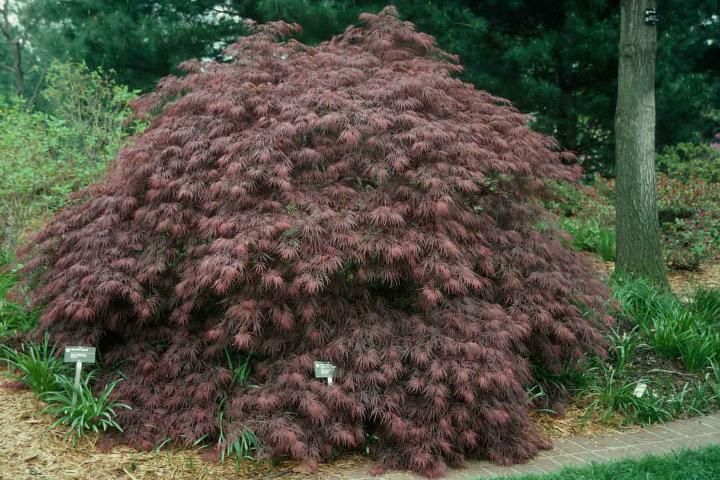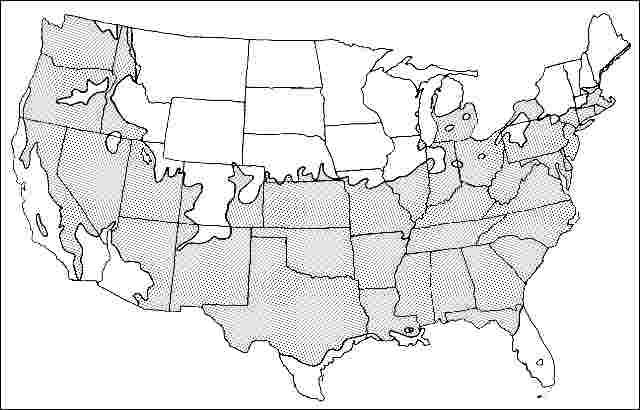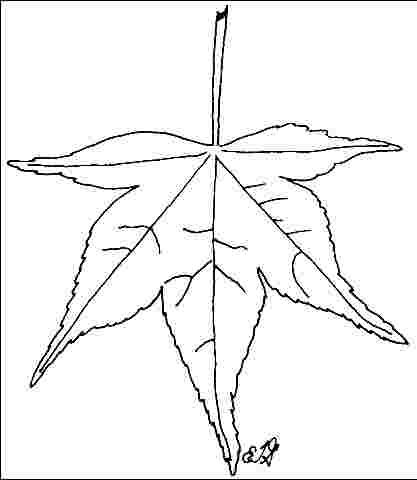Introduction
This Japanese maple has a mounded shape with an ultimate height of about 15 feet and a spread to about 20 feet. The dark red, simple leaves are finely divided into lobes, and the sinuses are so deep that leaves appear to be palmately compound. The slow growth rate makes this nicely suited to residential landscapes. Its popularity is due mostly to the delicate leaves that stay red for most of the summer. Leaves may turn to greenish red in the hot weather in the southern part of its range. The multiple trunks are muscular-looking, picturesque, grey, and show nicely when lighted at night. Fall color is reddish and less striking than other Japanese maples. The globose canopy shape looks best when it is allowed to branch to the ground. Lower foliage branches can be thinned to display the attractive bark and trunk structure.

Credit: Ed Gilman, UF/IFAS
General Information
Scientific name: Acer palmatum
Pronunciation: AY-ser pal-MAY-tum variety die-SEC-tum
Common name(s): 'Dissectum' Japanese maple
Family: Aceraceae
USDA hardiness zones: 5B through 9B (Figure 2)
Origin: not native to North America
Invasive potential: not assessed/incomplete assessment
Uses: container or planter; deck or patio; specimen; Bonsai

Description
Height: 10 to 15 feet
Spread: 10 to 15 feet
Crown uniformity: symmetrical
Crown shape: round, weeping
Crown density: dense
Growth rate: slow
Texture: fine
Foliage
Leaf arrangement: opposite/subopposite (Figure 3)
Leaf type: simple
Leaf margin: serrate, lobed
Leaf shape: star-shaped
Leaf venation: palmate
Leaf type and persistence: deciduous
Leaf blade length: 2 to 4 inches
Leaf color: purple/red
Fall color: orange
Fall characteristic: showy

Flower
Flower color: red
Flower characteristics: not showy
Fruit
Fruit shape: elongated
Fruit length: 0.5 to 1 inch
Fruit covering: dry or hard
Fruit color: red
Fruit characteristics: does not attract wildlife; not showy; fruit/leaves not a litter problem
Trunk and Branches
Trunk/bark/branches: branches droop; showy; typically multi-trunked; thorns
Pruning requirement: needed for strong structure
Breakage: resistant
Current year twig color: green, reddish
Current year twig thickness: thin
Wood specific gravity: unknown
Culture
Light requirement: partial sun or partial shade, shade tolerant
Soil tolerances: clay; sand; loam; acidic; well-drained
Drought tolerance: moderate
Aerosol salt tolerance: none
Other
Roots: not a problem
Winter interest: yes
Outstanding tree: yes
Ozone sensitivity: unknown
Verticillium wilt susceptibility: susceptible
Pest resistance: resistant to pests/diseases
Use and Management
Leaves can scorch in hot summer weather unless they are in some shade or irrigated during dry weather. More direct sun can be tolerated in the northern part of the range. Be sure drainage is maintained and never allow water to stand around the roots. Japanese maples grow fine on clay soils as long as the ground is sloped so water does not accumulate in the soil. They respond well to several inches of mulch placed beneath the canopy. Be sure to clear all turf away from beneath the branches so the lawn mower will not damage the tree.
This cultivar makes a nice specimen for planting in a lawn or low ground cover. Train the trunks and branches so they will not touch each other. Eliminate branches with included (embedded) bark or those which are likely to develop it as soon as possible. This reduces the likelihood of a branch splitting from the tree later when it has grown to become an important part of the landscape. Locate the tree properly, taking into account the ultimate size since the tree looks best if it is not pruned to control size. It can be the centerpiece of your landscape if properly located. Japanese maples have a reputation for transplanting from a field nursery poorly, but root-pruned plants and those from containers should do well.
Pests and Diseases
Poor growth in poorly drained soil. Often planted on raised beds or on high ground in clay soil. Aphids, scales, and borers can be found on the maples. Scorch occurs during periods of high temperatures accompanied by wind. Trees with diseased or inadequate root systems will also show scorching. Verticillium wilt can kill plants.